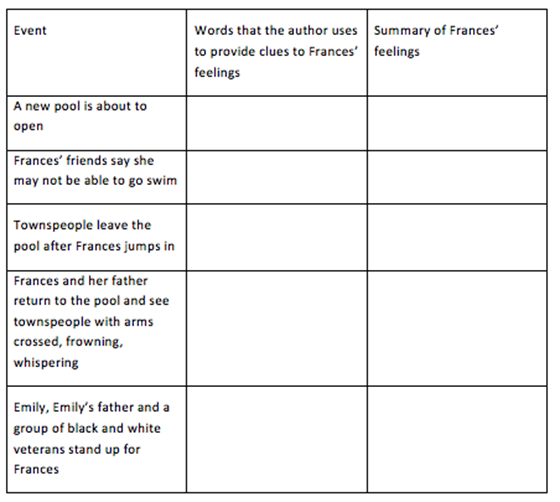Margaret Auguste’s story “The Day I Swam Into a New World” portrays how Frances—a girl of color in elementary school—anticipates and daydreams about the upcoming opening of a new public pool in her small Midwestern town. But it’s 1952, and as Frances hears from her peers, segregation might stop her from realizing this dream. You can use the activities and audio recording in this toolkit to engage fourth- through eighth-graders in close readings and read-alouds—and help them gain a stronger understanding of segregation and desegregation.
Essential Question
- How does “The Day I Swam Into a New World” portray segregation and desegregation through Frances’ experiences and feelings?
First Reading: Just the Facts
Distribute copies of “The Day I Swam Into a New World” to students and have them follow along on the printed copies as they listen to the audio recording of the story. Then, have students discuss the following questions as a group, providing evidence from the text.
- When the story begins, what does the protagonist, Frances, hope to do?
- What reasons do her friends give to suggest this might not be possible?
- What happens when Frances and her father first arrive at the pool?
- What happens when they return on the second day?
Second Reading: Clues to Feelings
Begin the second reading by displaying the chart below where students can see it.

Once again, have students listen to the audio recording while following along via the printed copies of the story. Pause after each story event and ask students to describe how Frances was feeling. What words does the writer use to convey these feelings to the reader? Complete the chart for each event.
You may wish to include the following points in the discussion:
- Words and phrases that describe Frances’ feelings: distant voices, lost in an imaginary world, daydreaming, feeling silly and wishing she had never said anything, gathering her courage, she was shocked, her heart soared
- Use of italics to indicate thoughts
- Words and phrases that describe actions: rolling his eyes, face grew hot, burst out laughing, voice barely a whisper, breathed in sharply, eyes lit up, breathed out slowly, eyes widened
- Adverbs: longingly, defiantly, gratefully
You may also wish to reinforce the use of punctuation as an aid to comprehension and reading aloud.
Third Reading: Read-Aloud
Assign sections of “The Day I Swam Into a New World” to pairs of students. Have them take turns reading aloud, giving them specific skills to monitor. For example, are they pausing at commas and stopping at periods? Are they using their voices to illustrate the emotions described by the author?
Further Reading
Use one of the books listed below to provide your students with another opportunity to practice close reading and read-aloud skills.
Through My Eyes by Ruby Bridges, edited by Margo Lundell (grades 4–5)
- Nonfiction, first-person account of six-year-old Ruby Bridges, the only black student to attend her New Orleans elementary school after a court-ordered desegregation in 1960
- Includes historic photos and commentary
- Winner of a Jane Addams Children’s Book Award and an NAACP Image Award nomination
The Watsons Go to Birmingham by Christopher Paul Curtis (grades 6–8)
- Historical fiction that focuses on the 1963 church bombing in Birmingham
- Winner of a Newbery Honor, a Coretta Scott King Honor and the Golden Kite Award
- Available as an audiobook

0 COMMENTS